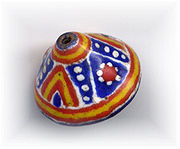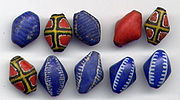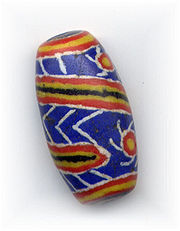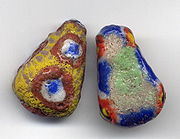
Kiffa beads
Encyclopedia


Powder glass beads
The earliest powder glass beads on record were discovered during archaeological excavations at Mapungubwe, in present-day Zimbabwe, and dated to 970-1000 CE. In our time, the main area of powder glass bead manufacture is West Africa, most importantly, Ghana...
named after the Mauritania
Mauritania
Mauritania is a country in the Maghreb and West Africa. It is bordered by the Atlantic Ocean in the west, by Western Sahara in the north, by Algeria in the northeast, by Mali in the east and southeast, and by Senegal in the southwest...
n city of Kiffa
Kiffa
Kiffa is a city and department in south-central Mauritania. Kiffa is capital of Assaba Region. It is located at around .It is famous for its antique Kiffa beads....
, where French
France
The French Republic , The French Republic , The French Republic , (commonly known as France , is a unitary semi-presidential republic in Western Europe with several overseas territories and islands located on other continents and in the Indian, Pacific, and Atlantic oceans. Metropolitan France...
ethnologist
Ethnology
Ethnology is the branch of anthropology that compares and analyzes the origins, distribution, technology, religion, language, and social structure of the ethnic, racial, and/or national divisions of humanity.-Scientific discipline:Compared to ethnography, the study of single groups through direct...
R.Mauny documented them first in 1949.
Kiffa bead
Bead
A bead is a small, decorative object that is usually pierced for threading or stringing. Beads range in size from under to over in diameter. A pair of beads made from Nassarius sea snail shells, approximately 100,000 years old, are thought to be the earliest known examples of jewellery. Beadwork...
s represent one of the highest levels of artistic skill and ingenuity in beadmaking, being manufactured with the simplest materials and tools available - pulverized European glass
Glass
Glass is an amorphous solid material. Glasses are typically brittle and optically transparent.The most familiar type of glass, used for centuries in windows and drinking vessels, is soda-lime glass, composed of about 75% silica plus Na2O, CaO, and several minor additives...
beads or fragments of them, bottle
Bottle
A bottle is a rigid container with a neck that is narrower than the body and a "mouth". By contrast, a jar has a relatively large mouth or opening. Bottles are often made of glass, clay, plastic, aluminum or other impervious materials, and typically used to store liquids such as water, milk, soft...
glass, pottery
Pottery
Pottery is the material from which the potteryware is made, of which major types include earthenware, stoneware and porcelain. The place where such wares are made is also called a pottery . Pottery also refers to the art or craft of the potter or the manufacture of pottery...
shards, tin can
Tin can
A tin can, tin , steel can, or a can, is a sealed container for the distribution or storage of goods, composed of thin metal. Many cans require opening by cutting the "end" open; others have removable covers. Cans hold diverse contents: foods, beverages, oil, chemicals, etc."Tin" cans are made...
s, twig
Twig
A twig is a small thin terminal branch of a woody plant. Twigs are critically important in identification of trees, shrubs and vines, especially in wintertime. The buds on the twig are an important diagnostic characteristic, as are the abscission scars where the leaves have fallen away...
s, steel needle
Sewing needle
A sewing needle is a long slender tool with a pointed tip. The first needles were made of bone or wood; modern ones are manufactured from high carbon steel wire, nickel- or 18K gold plated for corrosion resistance. The highest quality embroidery needles are plated with two-thirds platinum and...
s, some gum arabic
Gum arabic
220px|thumb|right|Acacia gumGum arabic, also known as acacia gum, chaar gund, char goond, or meska, is a natural gum made of hardened sap taken from two species of the acacia tree; Acacia senegal and Acacia seyal...
, and open fire
Fire
Fire is the rapid oxidation of a material in the chemical process of combustion, releasing heat, light, and various reaction products. Slower oxidative processes like rusting or digestion are not included by this definition....
s. The term Kiffa bead, named after one of the old bead making centres of Kiffa in Mauritania, was coined by United States
United States
The United States of America is a federal constitutional republic comprising fifty states and a federal district...
bead collectors during the 1980s.
According to Peter Francis, Jr., the making of powder glass beads in West Africa
West Africa
West Africa or Western Africa is the westernmost region of the African continent. Geopolitically, the UN definition of Western Africa includes the following 16 countries and an area of approximately 5 million square km:-Flags of West Africa:...
may date back a few hundred years, and to possibly 1200 CE in Mauritania. Maure
Maure
A Maure, since the 11th century, is the symbol of an African head. The term has Phoenician and Greek origins; see Moors.- U Moru :The main symbol in the coat of arms in Corsica is U Moru, Corsican for "The Moor", originally a female Moor blindfolded and wearing a necklace made of beads...
powder glass beads are believed to copy older, Islam
Islam
Islam . The most common are and . : Arabic pronunciation varies regionally. The first vowel ranges from ~~. The second vowel ranges from ~~~...
ic beads, of the type made in Fustat and elsewhere. Although the making of Mauritanian powder glass beads appears to be an ancient tradition, no archaeological evidence to establish their age has been found to date.



Production
Glass which is finely crushed to a powder is mixed with a binderBinder (material)
-See also:*Adhesive or Glue*Cement*Paint...
such as saliva
Saliva
Saliva , referred to in various contexts as spit, spittle, drivel, drool, or slobber, is the watery substance produced in the mouths of humans and most other animals. Saliva is a component of oral fluid. In mammals, saliva is produced in and secreted from the three pairs of major salivary glands,...
or gum arabic diluted in water. Decorations are made from the glass slurry
Slurry
A slurry is, in general, a thick suspension of solids in a liquid.-Examples of slurries:Examples of slurries include:* Lahars* A mixture of water and cement to form concrete* A mixture of water, gelling agent, and oxidizers used as an explosive...
i.e. crushed glass mixed with a binder and applied with a pointed tool, usually a steel
Steel
Steel is an alloy that consists mostly of iron and has a carbon content between 0.2% and 2.1% by weight, depending on the grade. Carbon is the most common alloying material for iron, but various other alloying elements are used, such as manganese, chromium, vanadium, and tungsten...
needle. The beads are placed in small containers, often sardine cans and heated to fuse the glass on open fires without moulds
Molding (process)
Molding or moulding is the process of manufacturing by shaping pliable raw material using a rigid frame or model called a pattern....
.
Kiffa beads were made in various shapes: blue, red, and polychromatic
Polychromatic
The term polychromatic means having several colours.It is used to describe light that exhibits more than one color. In a technical respect, this can also mean that it contains radiation of more than one wavelength. The study of polychromatics is particularly useful in the production of diffraction...
triangles with yellow, black, white, red and blue chevron-type and decorations that resemble eyes; blue, red and polychromatic diamond shaped beads; cigar shaped and conical beads as well as a variety of small spherical and oblate beads. Colour sequences observed on traditional beads with polychromatic decorations are always the same, i.e. red-yellow-black (dark brown)-yellow-red-white-blue-white. Often the obverse is decorated as well, and it is believed that different bead making families had their own distinct styles. For their wearers, all these beads held amulet
Amulet
An amulet, similar to a talisman , is any object intended to bring good luck or protection to its owner.Potential amulets include gems, especially engraved gems, statues, coins, drawings, pendants, rings, plants and animals; even words said in certain occasions—for example: vade retro satana—, to...
ic properties. The colours, shapes and the many different intricate decorative patterns all having specific meanings, most of them forgotten today.
Uses
Diamond-shaped beads were traditionally worn on braceletBracelet
A bracelet is an article of jewelry which is worn around the wrist. Bracelets can be manufactured from metal, leather, cloth, plastic or other materials and sometimes contain jewels, rocks, wood, and/or shells...
s, sewn onto strips of leather
Leather
Leather is a durable and flexible material created via the tanning of putrescible animal rawhide and skin, primarily cattlehide. It can be produced through different manufacturing processes, ranging from cottage industry to heavy industry.-Forms:...
and arranged in traditional sets composed of a specific ratio of blue to red to polychromatic specimens. Their patterns are believed to protect and to increase the fertility
Fertility
Fertility is the natural capability of producing offsprings. As a measure, "fertility rate" is the number of children born per couple, person or population. Fertility differs from fecundity, which is defined as the potential for reproduction...
of their wearers and it has been proposed that some might imitate cowrie shells. Triangular-shaped and spherical beads were worn as hair ornaments and traditional assemblages could be composed of two complementary sets of three triangulars each, one blue, one red and one polychromatic, worn at temple height. Many of the small spherical or oblate-shaped beads were hair ornaments or worn in necklaces in various combinations with other glass and stone beads and were made by decorating a red, blue or white preformed glass bead "core". Glass slurry decorations were applied to moulded 19th century beads possibly of Czech
Czech people
Czechs, or Czech people are a western Slavic people of Central Europe, living predominantly in the Czech Republic. Small populations of Czechs also live in Slovakia, Austria, the United States, the United Kingdom, Chile, Argentina, Canada, Germany, Russia and other countries...
origin. Smaller, cigar shaped or cylindrical beads are often also found to have been constructed from two or even three of the moulded beads. These are fragile and tend to break apart easily.
Modern beads
With the passing of the last of the remaining traditional bead makers during the 1970s, the craft became extinct. Since the early 1990s, organized groups of women bead makers are again making Kiffa beads, using basically the same traditional methods. The craftsmanship of the new beads, however, has never reached the high standards and the quality that can be observed in the old beads. Western artists have made their own versions in polymer clay or lampworked glass, but none of the modern creations come close to resembling the beauty of traditional specimens. The same applies to modern imitations made elsewhere, for instance in Indonesia.

